CSCI 5333 Data Base Management
System
Spring 2002 (1/14-5/6)
Chapter 15: Further Dependencies & Higher Normal Forms
15.1.1 Relation Decomposition and Insufficiency
of Normal Forms
- Looking at an individual relation to test whether
it is in a higher normal form does not, on its own, guarantee a good
design; rather, a set of relations that together form the relational
database schema must possess certain additional properties to ensure a
good design.
- The dependency preservation property
and the lossless (or nonadditive) join
property .
- A single universal relation schema
R = {A1, A2, ..., An} that includes all the attributes of the database
.
- A decomposition of R: D = {R1, R2,
R3, ..., Rm}.
- The attribute preservation condition
of a decomposition: Each attribute in R will appear in at
least one relation schema in the decomposition so that no attributes
are "lost".

- NOTE: Having each individual relation
R i in
the decomposition D to be in BCNF (or 3NF) may not be sufficient
to guarantee a good database design on its own.
- Problem: Spurious tuples out of a
natural join. Example: See Fig. 14.6.
15.1.2 Decomposition and Dependency Preservation
- The dependency preservation
condition (informal definition): Each
functional dependency f specified in F either appears
directly in one of the relation schemas R
i in the decomposition D
or could be inferred from the dependencies that appear in some
R i.
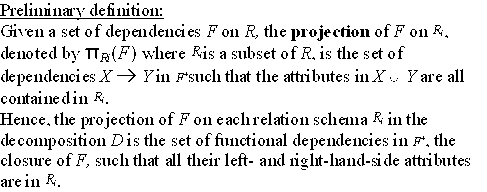
- Exercise: Examine
Fig. 14.12(a) and produce the projection of F on Lots1Ax. Repeat the
same process on Lots1Ay.

- An example of a decomposition
that does not preserve dependencies: Figure 14.12(a).
- Exercise: Verify the above
statement.
- Another example: Figure 14.13
with any of the three alternative decompositions
Alternative 1: {STUDENT, INSTRUCTOR}
and {STUDENT, COURSE}.
Alternative 2: {COURSE, INSTRUCTOR}
and {COURSE, STUDENT}
Alternative 3: {INSTRUCTOR, COURSE}
and {INSTRUCTOR, STUDENT}.
- Exercise: Verify that
alternative 1 decomposition is not dependency-preserving, with respect
to the original dependencies.
- The decompositions in Figure 14.11
are dependency-preserving.
- Exercise: Verify the
above statement.
- Claim 1: It is always possible
to find a dependency-preserving decomposition D with respect to F such
that each relation Ri in D is in 3NF.
(See Algorithm 15.1)
-
Minimal set of functional dependencies: (from Chapter
14)
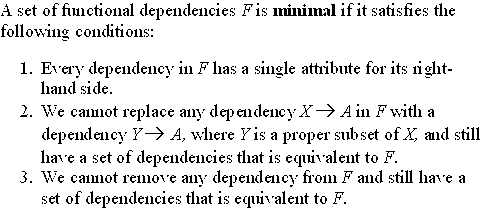
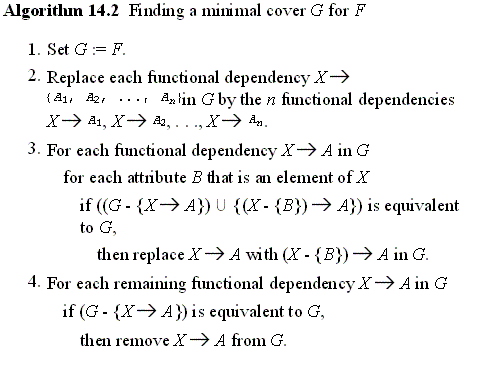
- Note: In step
3 of algorithm 14.2, suppose the new set of functional dependencies after
removing an attribute B is called G'. Then it is true that G' covers G. So
what's left is to show that G covers G'. A 'short cut' approach is to show
that the new functional dependency (X - {B]) --> A in G' can be inferred
from G.
- Another exercise: Apply algorithm 14.2 to
find a minimal cover for F = {fd1, fd2, fd3, fd4} as defined for the relation
LOTS in Figure 14.11 on page 492.
Let LOTS = (p, c, l, a, pr, t).
Step 1: G = F.
Step 2: G = { p->c; p->l; p->a; p->pr;
p->t;
c, l -> p; c, l -> a; c, l ->
pr; c, l -> t;
c->t;
a->pr }
Step 3: Remove an attribute from the left hand side
(lhs) of the functional dependencies with multiple-attribute lhs, that is, c,
l -> p; c, l -> a; c, l -> pr; c, l -> t.. Each such removal
will result in a new set of functional dependencies, G'. Since G' always
covers G, what is left is to show that G covers G'.
3.a. (Removing attribute c from c, l -> p) Show that
l->p can be derived from G. (no)
3.b. (Removing attribute l from c, l -> p) Show that
c->p can be derived from G. (no)
3.c. (Removing attribute c from c, l -> a) Show that
l->a can be derived from G. (no)
3.d. (Removing attribute l from c, l -> a) Show that
c->a can be derived from G. (no)
3.e. (Removing attribute c from c, l -> pr) Show
that l->pr can be derived from G. (no)
3.f. (Removing attribute l from c, l -> pr) Show
that c->pr can be derived from G. (no)
3.g. (Removing attribute c from c, l -> t) Show that
l->t can be derived from G. (no)
3.h. (Removing attribute l from c, l -> t) Show
that c->t can be derived from G. (yes!)
So, at
the end of step 3,
G = { p->c; p->l; p->a; p->pr; p->t;
c, l -> p; c, l -> a; c, l -> pr;
c -> t;
c->t;
a->pr }
Step 4: Check each of the functional dependencies in
G to see if it can be removed. Each such removal results in a new set of functional
dependencies, G'. Since G always covers G', the job
left for us to do is to show that G' covers G.
4.a. Can p->c be removed? (not really!)
4.b. Can p->l be removed? (not really!)
4.c. Can p->a be removed? (not really!)
4.d. Can p->pr be removed? (yes, because p->a
and a->pr)
4.e. Can p->t be removed? (yes, because p->c and
c->t)
4.f. Can c,l->p be removed? (not really!)
4.g. Can c,l->a be removed? (yes, because c,l->p
and p->a)
4.h. Can c,l->pr be removed? (yes, because c,l->p
and p->pr)
4.i. Can c->t be removed? (yes, because of redundancy
in the set)
4.j. Can c->t be removed? (not really!)
4.k. Can a->pr be removed? (not really!)
So, at the end of step 4,
G = { p->c; p->l; p->a; p->pr;
p->t;
c, l -> p; c, l -> a; c,
l -> pr; c -> t;
c->t;
a->pr }
G = { p->c; p->l;
p->a; c, l -> p; c->t; a->pr} is a minimal cover of F.
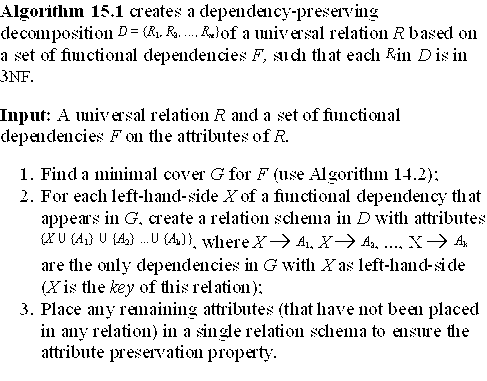
- Exercise:
Consider the relation schema EMP_DEPT in Figure 14.3(a) and the following
set G of functional dependencies on EMP_DEPT: G = {SSN --> {ENAME,
BDATE, ADDRESS, DNUMBER}, DNUMBER --> {DNAME, DMGRSSN}}.
Decompose EMP_DEPT by applying algorithm 15.1.
- Another Exercise:
Repeat the exercise by applying the algorithm on EMP_PROJ in Figure
14.3(b).
- Algorithm 15.1 is called the
relational synthesis algorithm
, because each relation schema in the decomposition is synthesized (constructed)
from the set of functional dependencies in G with the same left-hand-side
X.
Ø
Go to the
Index
15.1.3 Decomposition and Lossless (Nonadditive) Joins
- Nonadditive join property
ensures that no spurious tuples are generated when a NATURAL JOIN
operation is applied to the relations in the decomposition.

- The word
loss in lossless refers
to loss of information, not to loss of tuples.
- The term
nonadditive join is preferred.
- Algorith 15.2:
Testing for the nonadditive join property
- Input: A universal relation
R, a decomposition of R, and a set F of functional dependencies.
- Algorithm 15.2 allows
us to test whether a particular decomposition D obeys the lossless join
property with respect to a set of functional dependencies F.
- Once a row consists
only of "a" symbols, we know that the decomposition has the lossless
join property, and we can stop applying the functional dependencies (Step
4 of the algorithm) to the matrix S.
- An example of
testing the algorithm: See Fig. 15.1(a).
- Another example:
Fig. 15.1 (c).
- Some properties of
lossless join decompositions:

- Exercise:
Verify the property by using examples in Section 14.3 and Section
14.4.
- p.489: Figure 14.10(b)
- p.492: Figure 14.11(a)(b)
- p.492: Figure 14.11(b)(c)
- The "transitive"
property:
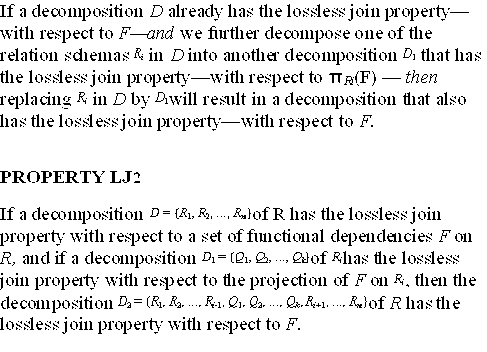
- Algorithm
15.3: Relational decomposition into BCNF relations with lossless
join property
- Input: A
universal relation R and a set of functional dependencies F on the attributes
of R.
- Review: Fig.
14.11, 14.12, and 14.13.
- Algorithm
15.4: Relational
synthesis algorithm with dependency preservation and lossless
join property.
- Input: A universal
relation R and a set of functional dependencies F on the attributes of R.
- Outcome:
A decomposition D of R that satisfiies the following constraints:
- Preserves
dependencies.
- Has the
lossless join property.
- Is such
that each resulting relation schema in the decomposition is in 3NF.
- NOTE:
Algorithm 15.4 is a modification of Algorithm 15.1, which,
unlike 15.4, does not guarantee the lossless join property.
- Exercise:
Decompose
the TEACH relation on page 495 by applying algorithm 15.4
.
- Algorithm
15.4a: Finding a key K for relation schema R based on
a set F of functional dependencies.
- Exercise:
Apply
algorithm 15.4a to the EMP_PROJ relation on page 470 to determine the key
of the relation.
- Another
exercise:
Exercise 15.24 on page 525.
- It is not always
possible to find a decomposition into relation schemas that preserves dependencies
and allows each relation schema in the decomposition to be in BCNF (instead
of 3NF as in Algorithm 15.4). See Fig. 14.12 and 14.13.
Ø
Go to the
Index
15.1.4 Problems with Null Values and Dangling Tuples
- Problems
with Null Values:
- Problem
1: In general, whenever a relational database schema is designed where
two or more relations are interrelated via foreign keys
, particular care must be devoted to watching for potential null values
in foreign keys. This can cause unexpected loss of information in queries
that involve joins on that foreign key.
- Example:
See Figure 15.2(a)(b)
- Problem
2: Effect on built-in functions ?
- The "Dangling
Tuples" Problem
- See Fig.
15.3:
Dangling tuples are represented in only one of the two relations that represent
employees and hence are lost if we apply a natural join
operation.
Ø
Go to the
Index
15.2 Multivalued Dependencies and Fourth Normal Form
- Multivalued
dependencies are a consequence of first normal form.
- Informally,
whenever two independent 1:N relationships A:B and A:C are mixed
in the same relation, an MVD may arise.
- Example:
(See Fig. 15.4, p.515)
- ENAME -->>
PNAME: An employee may work on multiple projects.
- ENAME -->>
DNAME: An employee may have multiple dependents.
- Question:
Can
the last two tuples in Fig. 15.4 be removed?
- Formal Definition
of MVD:
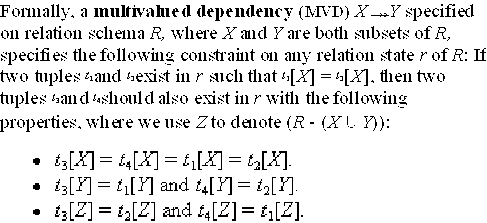
- Exercise:
Verify that
the EMP relation satisfies the above constraints.
15.2.2 Inference Rules for Functional and Multivalued Dependencies
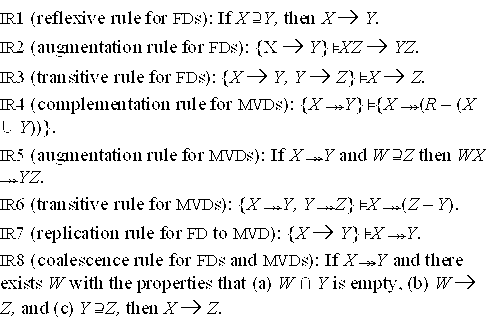
15.2.3 Fourth Normal Form

- An MVD
X -->> Y in R is a trivial MVD if either (a) Y is a subset
of X, or (b) the union of X and Y equals R.
-
Exercise:
Examine the EMP relation in Fig. 15.4(a) to determine
if it is in 3NF, BCNF, and 4NF. Justify your answers.
-
Problems with relations that are not in 4NF: waste of space + update
anomalies
-
Benefis of 4NF: See the illustration in Fig. 15.5.
-
Question:
Is the SUPPLY relaiton in Figure 15.4(c) in 4NF? Justify your answer.
-
NOTE:
Relations containing nontrivial MVDs tend to be all key
relaitons .
15.2.4 Lossless Join Decomposition into 4NF Relations

-
Exercise:
Verify that the decomposition of EMP into EMP_PROJECTS
and EMP_DEPENDENTS (p.515) is a lossless join decomposition.
-
Algorithm 15.5: Relational decomposition into 4NF relations with
lossless join property (modified from algorithm 15.3).
-
Exercise: Apply algorithm 15.5 to the EMP relation in Fig.
15.4(a).
Ø
Go to the
Index
15.3 Join Dependencies and Fifth Normal Form

-
An MVD is a special case of a JD where n = 2.

-
Example: The supplier-part-project relation in Fig. 14.4(c).
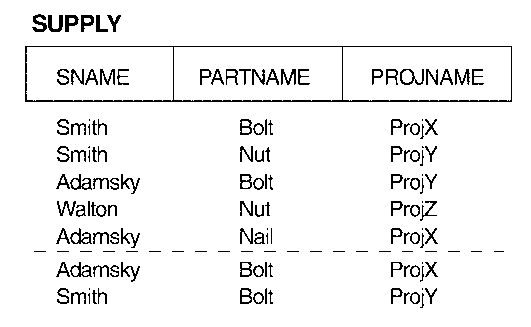
-
Exercise: Examine the above relation to determine why it is not in
5NF.
-
Decomposition into 5NF relations: See Fig. 14.4(d).

-
Another exercise: Verify the statement "Applying NATURAL
JOIN to any two of these relations produces spurious tuples, but applying
NATURAL JOIN to all three together does not."
Ø
Go to the
Index
|














